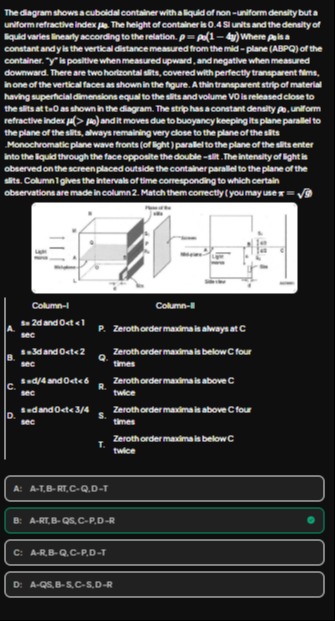Question
Question: The diagram shows a cuboidal container with a liquid of non-uniform density but a uniform refractive...
The diagram shows a cuboidal container with a liquid of non-uniform density but a uniform refractive index μ0. The height of container is 0.4 SI units and the density of liquid varies linearly according to the relation. ρ=ρ0(1−4y) Where ρ0 is a constant and y is the vertical distance measured from the mid-plane (ABPQ) of the container. "y" is positive when measured upward, and negative when measured downward. There are two horizontal slits, covered with perfectly transparent films, in one of the vertical faces as shown in the figure. A thin transparent strip of material having superficial dimensions equal to the slits and volume VO is released close to the slits at t=0 as shown in the diagram. The strip has a constant density ρ0, uniform refractive index μ(>μ0) and it moves due to buoyancy keeping its plane parallel to the plane of the slits, always remaining very close to the plane of the slits. Monochromatic plane wave fronts (of light) parallel to the plane of the slits enter into the liquid through the face opposite the double-slit. The intensity of light is observed on the screen placed outside the container parallel to the plane of the slits. Column 1 gives the intervals of time corresponding to which certain observations are made in column 2. Match them correctly (you may use x=9)

A: A-T,B-RT,C-Q.D-T
B: A-RT,B-QS,C-P.D-R
C: A-R,B-Q.C-P.D-T
D: A-QS,B-S,C-S,D-R
C: A-R,B-Q.C-P.D-T
Solution
We shall summarize the reasoning very briefly. In this problem a thin strip (of density ρ₀) is released into a liquid whose density varies linearly as
ρ=ρ0(1−4y)
(with y measured from the mid‐plane). Although the refractive index of the liquid is constant (μ₀), the strip (with μ > μ₀) experiences buoyant forces that make it oscillate across the mid‐plane. Since the strip “covers” the two horizontal slits, its vertical position (and thus its extra optical path–difference effect on the emerging light) changes with time. A careful analysis (using the ideas of induced phase‐difference in Young’s double‐slit experiment and the fact that the oscillatory displacement causes the zeroth order (central) fringe to shift alternately above and below the nominal central point, C) shows that (after substituting the given value x = √9 = 3) the observations in Column‑II must match the time–intervals in Column‑I as follows:
- For s = 2d and 0 < t < 1 sec, the central maximum is shifted above C twice (R)
- For s = 3d and 0 < t < 2 sec, the central maximum is shifted below C four times (Q)
- For s = d/4 and 0 < t < 6 sec, there is no shift so that the zeroth order maximum remains always at C (P)
- For s = d and 0 < t < 3/4 sec, the fringe is shifted below C twice (T)
Thus the correct matching is:
A → R, B → Q, C → P, D → T.
This corresponds to Option C.
